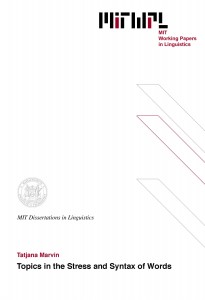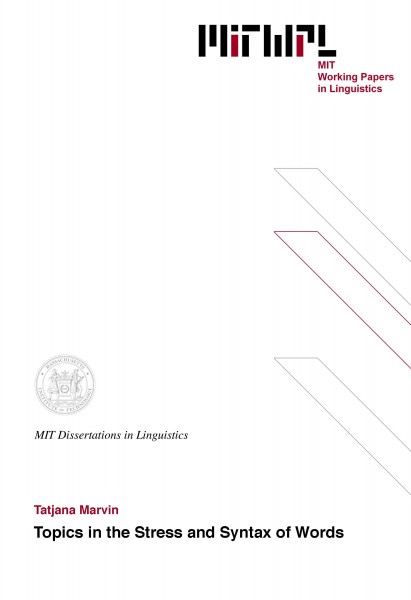Topics in the Stress and Syntax of Words
T. Marvin, 2002
This dissertation is a study of word structure showing that words exhibit the syntactic phenomenon of phase-by-phase Spell-Out, Chomsky (2001), Marantz (2001). The analysis of data from English and Slovenian indicates that the syntactic structure in word formation, specifically, the existence of phases at the word level, is necessary to make generalizations about the meaning and stress properties of words in these two languages. This result gives support to a theory of morphology that treats word formation as occurring in the Syntax component, following the same rules for syntactic phase formation, such as Distributed Morphology, Halle and Marantz (1993), Marantz (1997).
In Chapter 1 the basic ideas of Distributed Morphology are laid out. In Chapter 2 the central proposal of this dissertation is presented: category-forming phrases such as little v, n and a constitute Spell-Out domains, i.e. phases, at the word level. The idea is argued for with the example of English syllabification and schwa-insertion, showing that syllabification properties of derived words and the predictability of their meaning do not follow exclusively from diacritic markings on derivational affixes, but are reflexes of both idiosyncratic properties of affixes and of the syntax in which they are found. Chapter 3 deals with the interaction of stress assignment and the syntax of words in English, arguing that stress and vowel quality in English can be diagnostic of Spell-Out domains within words and that in turn syntactic domains predict the Spell-Out. Chapter 4 is an analysis of Slovenian participial nominalizations. It is first shown that these nominalizations are truly examples of nominalizing heads attaching to participial forms. And second, it is argued that their Spell-Out proceeds in phases defined by category-forming heads with the cyclic Spell-Out reflected in their stress pattern. Chapter 5 is a study of the stress patterns in Slovenian verbal environments and the interaction of stress and structure in these environments. The stress patterns are captured by positing two types of stress retraction rules the phonological ones and those referring to the syntactic structure.
Thesis supervisor: Alec Marantz
Table of Contents
Chapter 1..............11
Introduction............11
2 Distributed Morphology....... 12
2.1 Distributed Morphology as a theory of morphology.......... 12
2.2 Distributed Morphology as a theory of word structure......... 14
2.2.1 The notion of lexicon........... 15
Chapter 2 The syntax in words....... 17
Introduction.................17
2 Syntactic phenomena at the word level........ 17
2.1 Derivation by phase................18
2.2 The proposal in a nutshell........... 21
2.2.1 Technical execution.............. 23
2.3 Some background on little v.......... 26
2.4 Some conceptual considerations........ 29
3 Morphology, phonology and phases: English affixation.......... 31
3.1The prediction............ 31
3.2 English: syllabification and schwa insertion......... 34
3.2.1 Phonology and phases......... 34
3.2.2 Meaning and phases............. 39
3.2.3 Another argument for unaccusative phases.............. 39
Chapter 3 Stress assignment and phases in English............. 43
1 Introduction............... 43
2 The rules of English word stress........... 43
3 Stress assignment and Spell-out domains/phases ......... 48
4 Vowel quality and its relation to stress: SPE revival............. 51
4.1 Connection to the SPE model........ 55
5 A note on primary stress assignment and Spell-Out domains...........56
6 Problems: Halle (1998), Halle and Kenstowicz (1991).......... 58
6.1 Long underived words.............. 59
6.2 Derived words......... 60
7 Defending the SPE/phase view .......... 62
7.1 The conceptual issue..................... 63
7.2 A phase analysis of exceptions.............. 64
7.2.1 Acquiring subsidiary stress ............... 64
7.2.2 Losing subsidiary stress ...................66
8 A group of exceptions to SPE/phase analysis: Halle and Vergnaud (1987).......... 70
9 Other theories of morpho-phonology and phase/SPE approach ..........71
9.1 Lexical phonology.............. 72
9.1.1 Problems for lexical phonology............. 74
9.2 Halle and Vergnaud (1987)............. 76
9.3Phase/SPE approach between Kiparsky and Halle and Vergnaud........... 78
Chapter 4 The structure and stress of Slovenian nominalizations.......... 81
1 Introduction......... 81
2 The morphosyntax of Slovenian participles............. 83
2.1 L-participle (past participle)...........83
2.2 (E)n/t-participle (passive participle)............ 91
3 Slovenian participial nominalizations......... 92
3.1 The morphology of participial nominalizations............ 94
3.2 The meaning and structure of participial nominalizations......97
3.2.1L-participle nominalizations.......98
3.2.1.1 Agentive L-paritciple nominalization ........... 98
3.2.1.1.1 Linearization of agentive L-participle nominals...........104
3.2.1.2 Root L-participle nominalization......... 108
3.2.2 (E)n/t-participle nominalizations ......... 111
3.2.2.1 Verbal passive nominalization............. 111
3.2.2.2 Deadjectival (E)n/t-nominalization................113
3.3 A note on root nominalizations............ 118
4 Stress and phases in Slovenian participial nominalizations......... 119
4.1 Background assumptions: theory of stress.............. 120
4.2 A phase analysis of stress in participial nominalizations.........123
4.3 Other participial nominalizations..............128
4.4 Root nominalizations............. 130
4.5 Other examples of stress and structure interaction......... 130
Chapter 5 Stress pattern in Slovenian verbal environments........... 133
1 Introduction............133
2 Theoretical background.......... 134
2.1 Theory of stress.......... 134
2.2 Theory of lexical stress......... 134
2.3 Distributed Morphology....... 137
2.4 The syntax of words.......... 137
2.5 The phonology of words......... 138
3 Stress and accent in verbal environments data........ 138
3.1 Pattern A......... 139
3.2 Pattern B .........139
3.3. Pattern C .........140
4 Capturing stress in verbal environments............. 141
4.1 Arguing for three types of root accent............... 142
4.2 Applying root accentuation to individual forms........... 144
4.3 The structure of verb and the interaction between accent and rules of phonology....... 145
4.4 The infinitive......... 146
4.5 The present tense........... 147
4.5.1 Present tense retraction....... 149
4.6 The (E)n/t-participle............ 152
4.6.1 Interim conclusions...... 155
4.7 The l-participle and the short infinitive........... 156
4.7.1Disyllabic retraction in nouns and adjectives............ 160
5 The interaction of stress and syntax in verbal environments....... 161
Chapter 6 Concluding remarks............ 165

